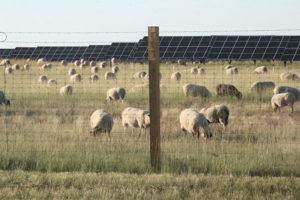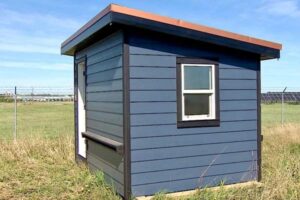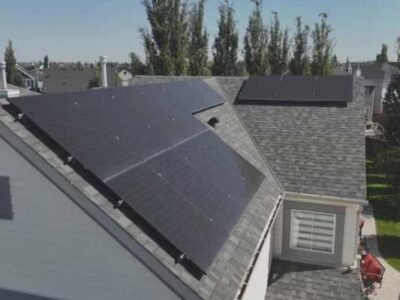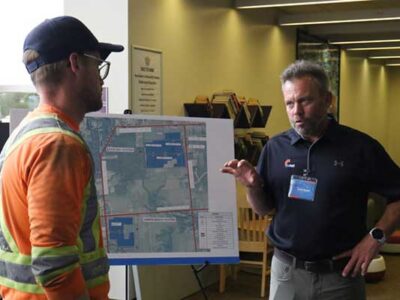- A solar project near Calgary now hosts animals, crops, and beehives in a bid to merge farming with solar energy.
- New technologies like mobile coops and climate-controlled apiaries are being tested to enhance productivity and sustainability.
- The initiative supports Alberta's policy shift toward requiring agriculture on solar sites and could serve as a model for future projects.
Every morning, as the prairie sun rises over a sprawling field of solar panels near Strathmore, Alta., a small mobile barn begins to move—half a metre at a time.
Inside are a flock of chickens pecking at the fresh grass below, leaving behind fertilizer as they go.
It might look like something from a science fiction farm. But for Janna Grier, it’s a glimpse of what the future could look like.
“This land isn’t just generating electricity,” said Grier, a sheep farmer and co-founder of Solar Sheep, a business that manages grazing on solar sites. “It’s producing food, improving the soil, and staying in agriculture.”
This summer, Capital Power’s solar farm—40 kilometres east of Calgary—isn’t just harnessing the sun for energy. It’s also home to 110,000 panels, 400 sheep, 100 chickens, 40 pigs, and soon, thousands of honeybees.
More than power

Sheep grazing on an Alberta Solar farm. (Photo by David Dodge, GreenEnergyFutures)
The 130-hectare site will generate about 40 megawatts of electricity on a sunny day, enough to power thousands of homes. But it’s also become a testing ground for what experts call agrivoltaics—the simultaneous use of land for both solar power and agriculture.
It’s a relatively new concept in Canada, but one with growing interest, especially in provinces like Alberta where solar capacity is expanding rapidly and tensions with rural landowners are rising.
“There’s this concern that solar is replacing farmland,” said Daniel Badiou, CEO of UKKÖ Robotics, a Manitoba-based company that makes the self-moving chicken coop now deployed on the site. “We’re trying to show that the two can actually enhance one another.”
The coop, which moves automatically several times a day, keeps chickens healthy while fertilizing and aerating the soil. It’s the first time UKKÖ has tested its technology at a solar farm.
Policy push
Concerns over farmland loss have prompted Alberta and Ontario to adopt rules requiring solar developers to include agricultural activity on prime land. These policies have created both hurdles and opportunities.
“We want to prove you can raise more local protein and food per acre—right under the panels,” said Grier. “There’s so much development happening. We can either fight it or find a better way to do it.”
High-tech hives

The Bee Cube mobile hut is a predator-proof, climate-controlled building that can house up to 20 hives. Each hut has sensors to monitor temperature, humidity, weight and the sound of the bees. (Kyle Bakx/CBC)
Soon, bees will join the mix, housed not in traditional wooden boxes but in climate-controlled mobile buildings built by Calgary startup Bee Cube. The structures, about the size of a shed, can host up to 20 hives and are outfitted with sensors that monitor conditions like temperature, humidity, and even the sound of the bees.
“All the data gets streamed in real time,” said Bee Cube founder Herman Van Reekum. “Eventually we’ll layer in AI to alert beekeepers before something goes wrong.”
The goal, he said, is to combat declining bee health while improving pollination of the wildflowers that grow between the solar panels.
A long-term experiment
Wade Heuscher, solar manager at Capital Power, said the company has launched a 10-year soil monitoring study to evaluate how grazing and crop rotation affect the land.
“One of the common criticisms is that solar farms lock up land for decades,” he said. “We’re showing it doesn’t have to be that way.”
Experts agree. A 2021 study by the National Renewable Energy Laboratory in the U.S. found that agrivoltaic systems can improve land productivity and reduce solar panel overheating, increasing energy efficiency by up to 10%.
What it means for Canadians
As more provinces ramp up solar deployment, projects like the Strathmore site offer a potential model—especially in rural regions where land-use debates are intensifying.
“Rethinking how we design solar sites could be a game-changer,” said Grier. “We don’t have to choose between farming and clean energy.”
For now, the chickens are laying eggs, the sheep are grazing, and the bees are buzzing—quiet proof that the two worlds might just work better together.
Adapted from an article written by Kyle Bakx. Kyle is a Calgary-based journalist with the network business unit at CBC News.












Comments